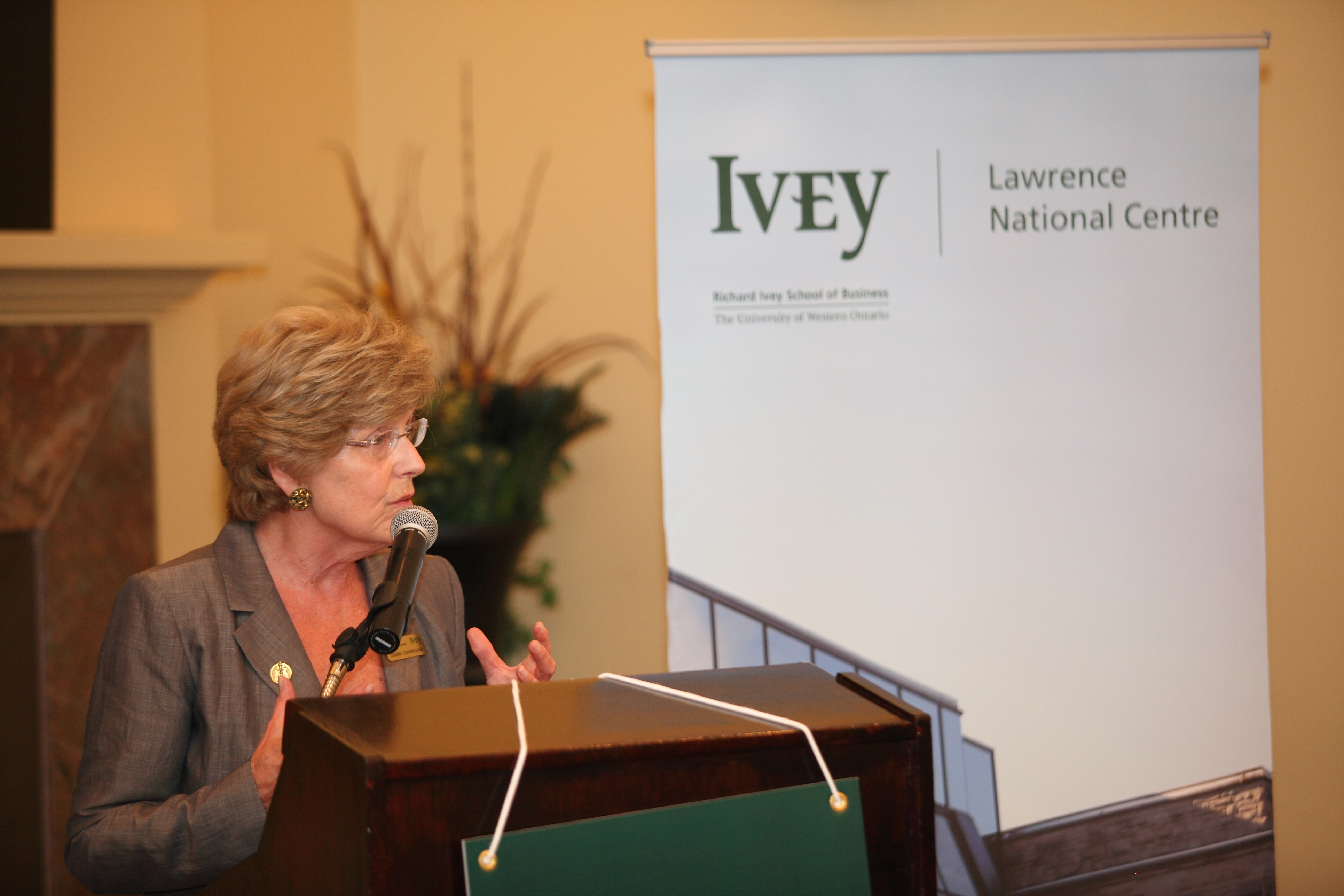
On June 14, the Lawrence National Centre for Policy and Management released a report on its Water Innovation Forum, held January 23-24, 2011, in collaboration with the Ontario Federation of Agriculture. The forum explored agriculture’s use of water and its connection to increased competitiveness and profitability for the sector, the location and distribution of water resources, economic opportunities and challenges related to water use and conservation, and current innovations in technology and sustainable water infrastructure. We spoke with director Dianne Cunningham to learn more about the forum’s outcomes and the subsequent report.
Water Canada: In the forum report, you write that the demand of rapid population growth, the effects of climate change, and the urgent need for improvement to governance processes and structures continue to pose challenges for the agriculture sector. If we were to work toward solving one of these problems now, what would it be, and how would we do it?
Dianne Cunningham: Climate change and population growth will have significant impacts on Canada’s water resources and agriculture outputs. Ontario’s population is projected to increase from 13 million in 2010 to 18 million by 2036. Addressing the urgent need for improvement to Ontario’s governance structure will provide a foundation to address these challenges.
A significant challenge raised at our Water Innovation Forum was the sector or issue-based approach to water management in Ontario. This leads to conflicting objectives, duplication of efforts and inefficiency in terms of human and financial resources. Additionally, many producers and entrepreneurs have trouble navigating our complex regulatory environment in a timely and cost-effective way, losing Ontario valuable business and investment. Streamlined processes, such as eliminating redundancies and providing a single point of contact to help navigate the regulatory system will create faster, smarter and new streamlined government to business services.
Another key recommendation proposes an integrated, multi-stakeholder approach, critical to addressing complex water and agriculture challenges. Although calling for less cumbersome governance while requesting more participation may seem at odds, they are actually complementary actions. Seeking out diverse perspectives from business, academia and all levels of government, before policy is implemented, supports stronger, more effective and meaningful governance processes.
What is the ideal governance structure for managing water? How should academia, government, the private sector, and everyday citizens be working together to make these decisions?
During the forum, we heard repeatedly that “water is local” and local governments, with their unique understanding of local circumstances, processes and timeframes, are often best positioned to address water management issues.
A successful example of local, place-based integrated management is the Lake Simcoe Protection Plan. The plan looks at all of the stresses on the lake, involves ongoing consultation with local experts, and requires official municipal plans to be consistent. This proved to be an effective framework for building participation through collaboration, with participants retaining the ownership and commitment to working together into the future.
Everyone has a role to play in developing a water management framework. The role of government is to try to balance competing interests and priorities through effective legislation and regulation, but government requires input from industry and academia. Producers, and others in the agriculture sector need to tell policy makers about the on-the-ground problems, the water realities and what works and what doesn’t in the practical application of policies. Academia’s role requires innovative, leading-edge research and long-term problem solving.
One of the major goals of Ontario’s Water Opportunities and Water Conservation Act is to drive innovation in the water sector. How should we ensure that there is adequate participation and input from the agricultural sector in certain elements of the act, such as the Water Technology Acceleration Project?
I think there is a lot of excitement about the Water Opportunities Act and WaterTAP. They are examples of forward-thinking policy in Ontario.
The agriculture and agri-food industry is one of the biggest water consumers; their continued success is directly tied to our water resources. It is important that they are represented in water governance deliberations. The report recommends that the Ontario Ministry of the Environment and the Ontario Ministry of Natural Resources should seek input from the Ontario Ministry of Agriculture, Food and Rural Affairs, as well as the Ontario Ministry of Economic Development and Trade, Ministry of Infrastructure, and Ministry of Municipal Affairs and Housing, and conservation authorities.
It is also important that the agriculture sector is represented on the board of WaterTAP. Collaboration is key, and with water being such an important part of the industry, the agriculture sector has proven their success in water innovation.
One might suppose that it would be difficult to encourage the agricultural community, traditionally quite reliant upon subsidies, to take the risks of adopting new water technology. How will early adoption of new water tech be encouraged and supported in this sector?
In our report, four cases of agri-food industry innovative water technology are described. A common message from the industry leaders is the need to create incentives for early innovators and reduce the risks associated with investing in new technology. This could be achieved through further economic incentives, not just with existing subsidies for pilot plants for research and development but also through non-cash incentives, such as 100 per cent depreciation of equipment in the first year of operation. Another key finding is that government regulation needs to keep up with new technology, otherwise innovation is stifled. Business and government should work with academia in supporting research and development, pilot projects, and demonstration plants, but also recognize that there is a need to do research in a full-scale environment. Stanton Farms in Ilderton is an excellent example of mutually beneficial full-scale test sites for the public and private sectors.
To encourage new water tech we also need to frame and communicate the business value and benefits in a more compelling way. Two cases in our report, PepsiCo (Frito Lay Canada) and Algoma Orchards, adopted new water tech for very different reasons. Many water conservation initiatives under Frito Lay’s “Net Zero” program resulted in direct benefits to the company’s bottom line in reduced operating costs. Additionally, it received international recognition. While Algoma Orchards adopted new tech to overcome water shortage issues, they also saw benefits in increased competitiveness and in attracting new environmentally-conscious customers such as Loblaws.
The report suggests promoting flexibility in water policy. Why is there a need for flexibility? Can you give an example of how this might work?
There is a significant difference between urban and rural use of water, as well as between water use in different regions, so a more flexible policy approach is required. Throughout the forum, it became clear that one size policy does not fit all. As an example, Frito Lay Canada’s manufacturing plant in Cambridge, Ontario reduced water consumption by 40 per cent. Because the water that was released was more concentrated, municipal surcharges increased by almost the same amount. These high water costs became a hindrance to the site competing for U.S. export volume and business. In this case, policy acts as a disincentive for water conservation.
A rural example is found in Leamington Area Drip Irrigation Inc, where restrictive 30-day average water-taking policies prevent LADII from delivering water to all of the growers interested in participating.
In the application of water policy, communication is key. We need to identify underlying assumptions and monitor actual program and policy outcomes. We have an opportunity and a responsibility to identify unintended consequences to improve future programs. With all of the tools that we have, there is still a need for improved practices and innovation.









